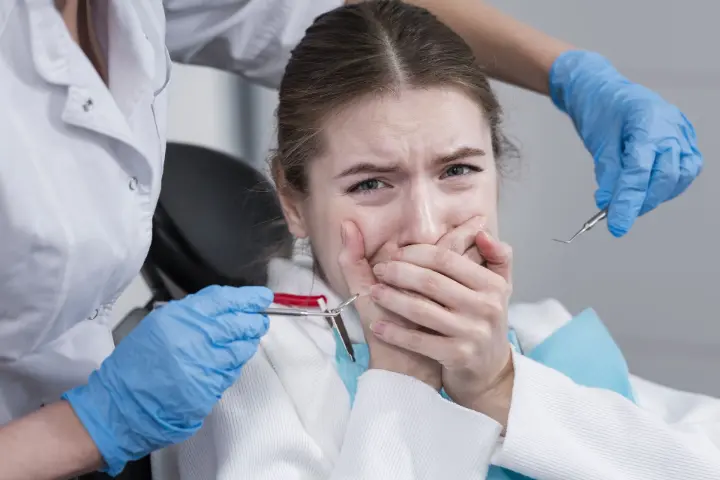That persistent tacky sensation. The water glass that never leaves your side. Waking with a mouth so dry it feels like parchment. If these experiences sound familiar, you're among the millions navigating xerostomia—commonly known as dry mouth—a condition that transcends mere discomfort to become a significant oral health concern.
At Vident Dental Clinic, we regularly meet patients who've silently endured dry mouth symptoms for years, unaware that effective solutions exist beyond simply drinking more water. This comprehensive exploration delves into the complex origins of oral dryness, its surprising health ramifications, and the most innovative approaches to finding lasting relief.
The Salivary Symphony: Understanding What's Being Disrupted
Dry mouth represents far more than insufficient hydration—it signals a fundamental disruption in one of the body's most remarkable yet underappreciated fluids.
The Multifaceted Marvel of Saliva
This extraordinary oral fluid performs an astonishing array of functions:
- Biological barrier creation: Forms a protective coating over delicate oral tissues
- Enzymatic pre-digestion: Initiates carbohydrate breakdown through salivary amylase
- pH equilibrium maintenance: Neutralizes destructive acids from both diet and bacterial metabolism
- Immunological protection: Contains immunoglobulins, lactoferrin, and other protective proteins
- Mineral delivery system: Supplies calcium, phosphate, and fluoride to tooth surfaces
- Sensory facilitation: Solubilizes food compounds for interaction with taste receptors
- Articulatory lubrication: Enables clear speech production and reduces tissue friction
When saliva production diminishes, this entire ecosystem becomes compromised, creating cascading effects throughout the oral cavity and beyond.
The Intricate Production Network
Understanding dry mouth begins with appreciating normal salivary physiology:
- Paired major glands: Three distinct types (parotid, submandibular, sublingual) with different secretion compositions
- Microscopic minor glands: Hundreds of tiny secretory units distributed throughout oral mucosa
- Neural regulation: Complex parasympathetic and sympathetic control mechanisms
- Compositional variations: Different stimuli trigger saliva with varying viscosity and component concentrations
- Temporal patterns: Natural flow fluctuations throughout the day and night
This sophisticated system can be disrupted at multiple levels—from central neural signaling to the microscopic secretory cells themselves.
The Multidimensional Origins of Oral Dryness
Xerostomia emerges from diverse pathways, often with several factors contributing simultaneously.
Pharmaceutical Influences: The Leading Culprit
Medication-induced dry mouth represents the most prevalent cause in developed countries:
- Receptor antagonism: Many medications block neurotransmitter receptors essential for salivary stimulation
- Neural pathway disruption: Some drugs interfere with autonomic signaling to salivary tissues
- Fluid balance alteration: Certain medications modify kidney function and overall hydration
- Cumulative burden: Each additional medication increases xerostomia risk exponentially
The medication categories most frequently associated with salivary disruption include:
- Antihypertensives (particularly thiazide diuretics, ACE inhibitors, and calcium channel blockers)
- Psychotropics (including antidepressants, antipsychotics, and anxiolytics)
- Antihistamines (both first and second-generation)
- Anticholinergics (prescribed for various conditions including overactive bladder)
- Opioid analgesics
- Certain respiratory medications
- Some gastrointestinal drugs
A comprehensive pharmacological review in the European Journal of Oral Sciences found that over 80% of the 200 most commonly prescribed medications list xerostomia as a potential side effect, with prevalence increasing dramatically in patients taking multiple medications.
Health Conditions with Salivary Impact
Various systemic disorders directly or indirectly affect salivary function:
- Autoimmune exocrinopathy: Sjögren's syndrome specifically targets moisture-producing glands
- Metabolic dysregulation: Uncontrolled diabetes alters fluid balance and glandular function
- Neurological conditions: Parkinson's disease, Bell's palsy, and stroke can affect neural control
- Psychogenic factors: Anxiety disorders and depression influence both perception and actual secretion
- Inflammatory processes: Sarcoidosis, amyloidosis, and other granulomatous conditions
- Endocrine imbalances: Thyroid dysfunction and hormonal fluctuations
Sjögren's syndrome deserves particular attention as it affects approximately 1-4 million Americans, predominantly women, with many cases remaining undiagnosed for years despite significant symptoms.
Iatrogenic and Treatment-Related Factors
Medical interventions themselves can directly compromise salivary function:
- Radiation therapy: Treatment fields encompassing salivary tissues can cause permanent damage
- Cytotoxic agents: Certain chemotherapeutics affect rapidly dividing salivary cells
- Surgical intervention: Procedures involving salivary glands or their innervation
- Hematopoietic stem cell transplantation: Associated with graft-versus-host disease affecting exocrine glands
Radiation-induced xerostomia is particularly significant, with up to 95% of head and neck cancer patients experiencing permanent salivary hypofunction despite advanced radiation delivery techniques designed to spare glandular tissue.
Behavioral and Environmental Contributors
Daily habits and environmental conditions frequently exacerbate underlying susceptibility:
- Respiration patterns: Chronic mouth breathing bypasses nasal humidification
- Hydration inadequacy: Insufficient fluid intake or excessive loss through exercise
- Atmospheric conditions: Low environmental humidity, particularly in heated or air-conditioned spaces
- Substance consumption: Alcohol, caffeine, and tobacco all modify salivary flow and composition
- Recreational substances: Cannabis, methamphetamine, and certain other drugs
- Occupational exposures: Environments requiring prolonged speaking or with airborne irritants
These factors often transform borderline salivary function into symptomatic xerostomia, particularly when combined with other risk factors.
Beyond Discomfort: The Cascading Consequences of Salivary Deficit
The implications of chronic dry mouth extend far beyond momentary discomfort, potentially triggering a progressive sequence of oral health complications.
Immediate Functional Disruptions
The most noticeable effects impact daily activities:
- Communication challenges: Difficulty with prolonged speaking or certain phonetic sounds
- Gustatory alterations: Diminished taste perception, particularly for subtle flavors
- Nutritional interference: Problems forming food bolus and initiating swallowing
- Prosthetic complications: Reduced denture retention and increased tissue irritation
- Sleep fragmentation: Nighttime awakening due to extreme dryness and thirst
These quality-of-life impacts often drive patients to seek help, though many endure symptoms for years before recognizing effective solutions exist.
The Accelerated Caries Pathway
Without saliva's protective mechanisms, tooth decay patterns change dramatically:
- Location shift: Development of decay in typically resistant areas like incisal edges and cusp tips
- Progression velocity: Rapid advancement from early enamel lesions to cavitation
- Pattern changes: Circular caries around the neck of teeth (sometimes called "radiation caries")
- Restoration vulnerability: Increased failure of existing dental work due to secondary decay
A landmark clinical investigation published in Special Care in Dentistry documented that patients with severe xerostomia developed an average of 3.5 new carious lesions within just six months—a rate approximately eight times higher than matched controls with normal salivary function.
Mucosal Vulnerability Syndrome
Oral soft tissues suffer significantly without adequate lubrication:
- Frictional damage: Increased tissue sloughing and irritation during normal function
- Inflammatory enhancement: Exaggerated tissue response to minor irritants
- Microtrauma susceptibility: Greater likelihood of small injuries during eating
- Reduced healing capacity: Delayed tissue repair without saliva's growth factors
- Sensory disturbances: Development of burning sensations or altered perception
These mucosal changes create a cycle of increasing sensitivity and discomfort that can significantly impact quality of life.
Microbial Ecosystem Disruption
The oral microbiome undergoes dramatic restructuring with chronic xerostomia:
- Community composition shifts: Increases in acidogenic and aciduric species like Streptococcus mutans and Lactobacillus
- Candida colonization: Elevated prevalence of fungal overgrowth without saliva's antifungal components
- Biofilm architecture changes: Development of more complex, treatment-resistant plaque structures
- Volatile sulfur compound production: Increased halitosis due to bacterial metabolic shifts
Advanced microbiome analysis using 16S rRNA sequencing has demonstrated that xerostomia patients harbor significantly less diverse oral bacterial communities with overrepresentation of potentially pathogenic species—changes that persist even with symptomatic treatment.
The Broader Health Canvas
Emerging research suggests wider health implications beyond the oral cavity:
- Dietary narrowing: Avoidance of nutritious but difficult-to-eat foods like raw vegetables
- Pharmacological compliance challenges: Difficulty swallowing medications as prescribed
- Digestive inefficiency: Reduced initial carbohydrate processing and bolus formation
- Social dimension impact: Withdrawal from conversations and dining experiences
- Psychological burden: Frustration, embarrassment, and reduced quality of life
These extended effects highlight why xerostomia deserves comprehensive attention rather than simplistic "drink more water" advice.
Diagnostic Precision: Identifying the Unique Patterns of Each Case
Effective management begins with thorough diagnosis of both the condition itself and its underlying causes.
Clinical Assessment Framework
At Vident Dental Clinic, our dry mouth evaluation protocol includes:
- Symptom chronology mapping: Detailed timeline of onset, progression, and fluctuation patterns
- Visual tissue analysis: Assessment of mucosal appearance, tongue papillary changes, and saliva pooling
- Glandular examination: Evaluation of major salivary glands for enlargement, tenderness, or expressible secretions
- Functional testing: Simple chairside assessments including tongue-blade adhesion and lipstick sign
- Dryness distribution analysis: Mapping of which oral regions experience greatest dryness
These clinical evaluations provide valuable initial insights into severity, potential causes, and most affected areas.
Quantitative Measurement Approaches
When indicated, objective testing may include:
- Resting flow rate determination: Collection and measurement of unstimulated saliva over a standardized time period
- Stimulated output assessment: Evaluation of salivary response to standardized stimulation methods
- Compositional analysis: Laboratory evaluation of salivary components and properties
- Glandular imaging: Ultrasound, sialography, or MRI studies when structural abnormalities are suspected
- Minor gland biopsy: Tissue sampling when autoimmune conditions are suspected
These objective measures help distinguish between hyposalivation (reduced flow), compositional alterations, and perceived dryness with normal function—distinctions that significantly impact treatment approaches.
Collaborative Diagnostic Networks
Complex cases benefit from coordinated multidisciplinary assessment:
- Rheumatological consultation: For evaluation of potential autoimmune contributors
- Neurological assessment: When central or peripheral nervous system factors are suspected
- Endocrine evaluation: For investigation of metabolic or hormonal influences
- Psychological dimension: Assessment of anxiety, depression, or stress-related components
- Sleep medicine input: When breathing patterns or sleep disorders may contribute
This integrated approach ensures comprehensive identification of all contributing factors rather than focusing on isolated symptoms.
Management Architecture: Building a Personalized Relief Strategy
Effective dry mouth management typically requires a multifaceted approach tailored to individual circumstances and causes.
Foundational Interventions: Addressing Root Causes
When possible, modifying underlying factors offers the most definitive approach:
- Medication reconsideration: Collaborative review with prescribing physicians to identify alternatives with lower xerogenic potential
- Dosage timing optimization: Strategic scheduling to minimize symptom impact during critical periods
- Medical condition management: Improved control of contributing health conditions
- Behavioral modification: Addressing habits like mouth breathing or excessive caffeine consumption
- Environmental engineering: Humidity optimization, especially in sleeping environments
While not always possible to eliminate underlying causes entirely, even modest adjustments can yield significant symptomatic improvement.
Salivary Stimulation Strategies
For functional but underactive glands, various stimulation approaches can enhance natural production:
- Mechanical stimulation: Sugar-free gums containing xylitol, which provide dual benefits of stimulation and bacterial inhibition
- Gustatory activation: Specifically formulated lozenges with malic acid or citric acid in appropriate concentrations
- Pharmacological stimulation: Prescription sialagogues like pilocarpine and cevimeline for suitable candidates
- Neuroelectrical approaches: Emerging technologies that deliver mild electrical stimulation to trigger salivary reflexes
- Acupuncture protocols: Evidence-supported techniques targeting specific points associated with salivary function
A randomized controlled trial published in the International Journal of Dental Hygiene demonstrated that combining mechanical and gustatory stimulation increased salivary flow by up to 200% in medication-induced xerostomia patients, with effects lasting up to 30 minutes post-stimulation.
Substitution and Supplementation Approaches
When stimulation proves insufficient, replacement strategies provide symptomatic relief:
- Biomimetic substitutes: Advanced formulations containing carboxymethylcellulose, hydroxyethylcellulose, or mucin
- Extended-release systems: Adhesive discs or slowly dissolving tablets for sustained relief
- Lipid-rich preparations: Oil-based products that create longer-lasting moisture barriers
- Enzyme-supplemented solutions: Products containing lysozyme, lactoferrin, or lactoperoxidase
- Specialized overnight formulations: Higher-viscosity products designed for sleep-time symptom control
The ideal substitution approach depends on individual symptom patterns, remaining salivary function, and specific deficiencies in the patient's natural saliva.
Preventive Fortification Protocol
Enhanced preventive measures become essential with chronic xerostomia:
- High-concentration fluoride systems: Prescription-strength products containing 5000 ppm fluoride
- Calcium-phosphate technology: Remineralizing systems that supply essential minerals to vulnerable surfaces
- Antimicrobial integration: Targeted agents to control pathogenic bacterial overgrowth
- pH optimization strategies: Products that help maintain less acidic oral environment
- Professional application schedule: More frequent in-office preventive treatments
A controlled clinical trial published in Caries Research found that implementing a comprehensive preventive protocol including high-concentration fluoride, calcium phosphate supplements, and xylitol products reduced new caries incidence by 72% in xerostomia patients compared to standard preventive care.
Lifestyle Architecture
Practical daily adjustments can significantly improve comfort and function:
- Hydration choreography: Strategic fluid consumption patterns throughout the day
- Dietary texture modification: Incorporating moisture-rich foods and lubricating additions
- Nighttime environment design: Optimizing bedroom humidity and breathing patterns
- Lip and oral tissue protection: Specialized products for vulnerable external surfaces
- Symptom tracking: Identifying and avoiding personal trigger factors
These quality-of-life adaptations, while seemingly straightforward, often provide substantial symptomatic improvement when systematically implemented.
The Vident Comprehensive Care Model for Xerostomia
At Vident Dental Clinic, we've developed a structured yet flexible approach to dry mouth management that addresses both immediate symptoms and long-term oral health preservation.
Individualized Assessment Protocol
Our approach begins with thorough evaluation:
- Comprehensive analysis of medical history, medication regimens, and symptom patterns
- Objective measurement of salivary parameters when indicated
- Detailed mapping of oral health status with specific attention to early warning signs
- Evaluation of current management attempts and their effectiveness
- Identification of personal priorities and most troublesome symptoms
This detailed assessment allows us to develop truly personalized recommendations rather than generic advice.
Customized Intervention Architecture
We design specific management regimens based on individual needs:
- Personalized product selection matched to your specific symptom pattern
- Precise application schedules for optimal effectiveness
- Tailored techniques addressing your unique manifestations
- Integration with existing health routines for sustainable implementation
- Regular refinement based on your feedback and response
This tailored approach ensures you're not wasting resources on products or techniques unlikely to benefit your specific condition.
Enhanced Professional Care Sequence
Our in-office protocols for xerostomia patients include:
- Modified instrumentation techniques that respect vulnerable tissues
- Application of professional-grade protective compounds
- Careful monitoring of early demineralization indicators
- More frequent assessment intervals when risk factors warrant
- Coordination with other healthcare providers to address underlying causes
These professional interventions complement home care strategies to provide comprehensive protection.
Longitudinal Support Framework
We recognize that xerostomia management requires ongoing adaptation:
- Scheduled reassessment of effectiveness and symptom control
- Modification of recommendations as medical conditions or medications change
- Introduction of emerging products and techniques as they become available
- Seasonal adjustments to address environmental fluctuations
- Long-term vigilance for potential complications
This continuous care model ensures that your management strategy evolves with your changing needs and with advances in treatment options.
Horizon Perspectives: Emerging Approaches to Dry Mouth
The research landscape continues to advance with promising developments for xerostomia management.
Regenerative Frontiers
Exciting research directions may eventually offer more definitive solutions:
- Mesenchymal stem cell therapy: Investigations into salivary gland regeneration using adult stem cells
- Gene therapy vectors: Experimental approaches to restore salivary protein production
- Tissue engineering constructs: Development of bioengineered salivary gland replacements
- Growth factor applications: Targeted delivery of compounds that stimulate tissue repair
- Bioactive scaffold materials: Novel structures that support cellular regeneration
While primarily in investigational phases, these approaches offer hope for more definitive treatment options in the future.
Technological Innovation Pathways
New devices and delivery systems show significant promise:
- Intraoral electrostimulation: Miniaturized devices that enhance salivary neural signaling
- Controlled-release systems: Smart polymers that respond to environmental triggers
- Ultrasonic nebulization: Fine-mist delivery systems for optimal mucosal coverage
- Digital monitoring platforms: Technologies that track symptoms and effectiveness
- 3D-printed delivery vehicles: Customized appliances for precise medication application
These technological approaches may offer more convenient and effective symptom management with reduced side effects.
Microbiome Modulation Strategies
Emerging research focuses on rebalancing the oral ecosystem:
- Targeted probiotic formulations: Beneficial bacteria specifically selected to counter xerostomia-related dysbiosis
- Prebiotic compounds: Substrates that selectively nourish beneficial bacterial populations
- Bacteriocin delivery: Natural antimicrobial peptides that target specific pathogenic species
- Biofilm disruptors: Compounds that prevent harmful microbial organization
- Metabolic modifiers: Agents that shift bacterial activity toward less damaging patterns
The oral microbiome represents a promising frontier in preventing the consequences of xerostomia through ecological rather than symptomatic approaches.
Conclusion: Reclaiming Oral Comfort and Health
Dry mouth may be common, but it should never be dismissed as an inevitable nuisance or minor complaint. With proper assessment, targeted interventions, and consistent management, most patients can experience significant improvement in both symptoms and long-term oral health outcomes.
At Vident Dental Clinic, we believe that effective xerostomia management requires more than simply recommending a mouthwash or lozenge. Our comprehensive approach addresses underlying causes when possible, implements evidence-based interventions, and provides ongoing support to ensure optimal results.
If you're experiencing dry mouth symptoms—whether occasional discomfort or chronic severe dryness—we invite you to schedule a consultation. Together, we can develop a personalized strategy to restore oral comfort, function, and health.
This article provides educational information about dry mouth management. For personalized recommendations, please schedule a consultation with our dental team at Vident Dental Clinic.


